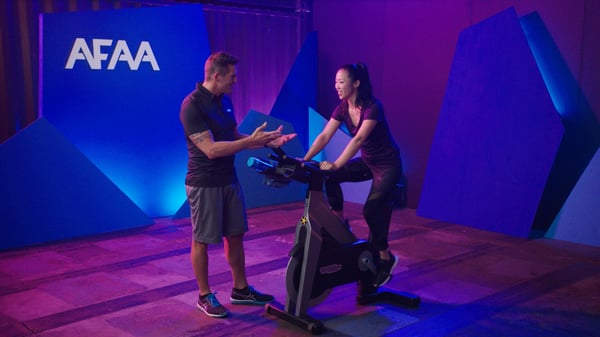
Whether you are new to indoor cycling or a seasoned rider, having the proper form on the bike is essential. Not only does it ensure a more comfortable ride, but it also minimizes the risk of injury and improves efficiency and performance on the bike.
Having a proper form on an indoor bike starts with making sure the bike is correctly set up to compliment your skeletal frame. If this doesn't happen, then it’s unlikely that you will ever have the correct form on the bike.
Look at it like trying to fit a square peg into a round circle…unless they both match up, it's not going to work.
2 Ways to Set up Your Indoor Bike Properly: Quick and Measured Fits
Let’s start by going over the correct way to set up your indoor bike. There are two independent processes that you can follow. The first is called a Quick Fit. This is where the adjustments are made by eyeballing the measurements followed by making changes based on feel while riding the bike. The second process is called a Measured Fit. This is a much more detailed fit using equipment that can accurately measure angles (protractor) and straight lines (a string attached to a bob). The Measured Fit takes more time and typically requires someone else to help.
There are four key features on most indoor bikes that enable you to adjust the measurements on the bike for a custom fit:
- Height of the saddle (up and down)
- Height of the handlebars (up and down)
- Fore and aft the saddle (front to back)
- Fore and aft of the handlebars (front to back)
Doing a Basic Bike Fit in 6 Steps
To do a basic bike fit requires a few steps. Follow along closely and get set up in no time!
1. Begin by standing with your feet flat on the floor directly beside your bike and adjacent to the saddle. Set the height of the saddle, so it lines up with the top of your hip bone.2. Set the saddle fore and aft in the neutral position (at the center of the saddle rail). This is the rail that allows the saddle to move towards and away from the handlebars. Next, set the handlebars at the same height as the saddle.
3. Finally, set the fore and aft position of the handlebars by placing an elbow at the front of the saddle called the nose, then with an open handle, adjust the distance of the handlebars to the end of the longest finger. This is your baseline set up.
4. From here, get on the bike and clip in with cycling shoes or place your feet in the cages if you don't have cycling shoes (Note: For safety reasons, I would not recommend riding an indoor bike if your feet aren't anchored on to the pedals. You run the risk of your feet slipping off, which could potentially cause a severe injury.)
Note: Once on the bike, start pedaling and pay close attention to your legs when your feet are at the bottom of the pedal stroke. (I am going to refer to this as the 6 o'clock position on the dial). If you feel your legs go completely straight or if you feel like you are sitting in a chair lifting your knees toward the ceiling with little to no movement in the knee joint, then these are indicators that your saddle is either too high or too low. The ideal saddle height is when you have a slight bend in the knee when your foot is at 6 o’clock.
5. Next, let’s adjust the saddle’s fore and aft position. With your ‘sit bones’ placed on the widest part of the saddle, start pedaling and look down at your feet. If you can see the front of your shoes through the entire rotation of the pedal stroke, then the saddle is positioned too far back. If you never see the front of your shoes, the saddle is too far forward. The ideal position is when the front of your shoes disappear for a slight second on the upstroke and at 12 o’clock and see them through the downstroke.
6. Now let’s adjust the handlebars. With your hands placed on the handlebars, pay attention to your arms. If they are fully extended (no bend in your elbows), then this is an indicator that the handlebars are placed too far forward. If the elbows are significantly bent to where you feel tension across your chest in a neutral spine position, the handlebars are too close to the saddle. The ideal position is to have your elbows slightly bent (referred to as being ‘soft’) with your shoulders down away from the ears and in a relaxed position.
Remember! The height of the handlebars can be a matter of preference for most riders. Outdoor cyclists and triathletes typically like to place their handlebars in a lower position for a more aerodynamic position. If this is your preference, make sure that your quad is not contacting your torso on the upstroke. If that's the case, then the handlebars are too low and need to be raised. In general, the placement of the handlebars should put you in a position where you have a slight lean forward with a neutral spine hinging from the hips.
A Measured Bike Fit in 6 Measurements
Begin the Measured Fit by going through the same process noted above to set your baseline. Once on the bike, you will take three measurements:
- The angle from the femur to the tibia taken at the knee joint using the protractor
- The angle from the femur to the pelvis bone taken at the hip joint using the protractor
- Placement of the saddle’s fore and aft by placing the string attached to the bob at the front the knee and measuring the position of the bob at the 3 o’clock position using the metatarsal bone as the reference point
The final measurements should look like this:
4. The angle at the knee joint: 25 to 35-degree flexion5. The angle at the hip bone: 40 to 45-degree flexion
6. Placement of the bob: Middle of the metatarsal bone
Do A Test Run!
Now that we have walked through the correct way to set up the bike properly, everything else should fall in to place when it comes to form. As I mentioned in the beginning, having the proper form on an indoor bike helps with comfort, improves performance, and minimizes injury.
For someone new to indoor cycling, it may take a couple of rides to determine if the bike is correctly set up. Allow your body to adapt to the bike set up. If you are feeling discomfort in any of the target areas note on the table below, then there is a good chance the bike is not set up correctly.
|
Target Area |
Cause |
|
Strain in the back of the knee |
· The saddle is too and/or too far back |
|
Strain in the front of the knee |
· The saddle is too low and/or too far forward |
|
Soreness in the shoulders/trapezoids |
· Handlebars are too high and/or too close to the saddle |
|
Lower back discomfort |
· Handlebars are too far forward and/or saddle too far back · The saddle is too close to the handlebars |
When making changes to the bike set up, I would suggest starting small and go through a process of elimination until the discomfort goes away.
Once you feel like it’s the perfect fit, write down the measurements, so have the same settings for every ride. Most indoor bikes will have markers at the adjustments that you can use a reference.
A Checklist for Correct Indoor Cycling Form and Posture
Now that your bike set up correctly, your body’s riding position should be with a lifted chest elongating the spine, relaxed shoulders, soft elbows, slightly lean forward by bending at the hips.
One more important tip when it comes to riding is to think about forming big circles with your pedal strokes versus ‘mashing’ the pedals (pushing straight down and pulling straight up). ‘Circular pedaling’ will increase your pedal efficiency so you can generate more power for a longer period of time.
Lastly, it’s important to note that maintaining good posture while riding helps with your breathing. When the chest is open, there is less restriction of oxygen and carbon dioxide exchange, something you will need when you are in an anaerobic state.
Different Positions on the Bike
Most rides require the rider to move in and out of the saddle. There should not be much of a change in the body position when coming out of the saddle. When out of the saddle, the load should be distributed over the top of the pedals and not on the handlebars. The handlebars should only be used for balance in this position. If you find yourself leaning forward into the handlebars, shift your hips back, so they are over the top of the nose of the saddle.
How to do Tap Backs The Right Way
A frequent movement in several of the rhythmic indoor cycling formats is a "Tap Back." This is where the body moves front to back on the bike with the beat of the music.
Proper form for Tap Backs is to
- Keep the bodyweight over top of the pedals and then slightly shift the hips from the nose of the saddle to the rear of the saddle and back to the nose.
- The upper body should remain in a static position throughout the movement.
- The travel distance is relatively short, but the movement is effective in building strong quads.
- Make sure to keep the core engaged throughout the movement as well. This will help with balance and stability on the bike, plus improve your core strength.
Become an Indoor Cycling Instructor!
After you are a master at indoor cycling form and learn the posture and movements required for safe riding, you might just find yourself wanting to teach everyone you know the joys of safe cycling!
If you are interested in learning more about becoming an indoor cycling instructor, head over to our page and inquire about being certified.

